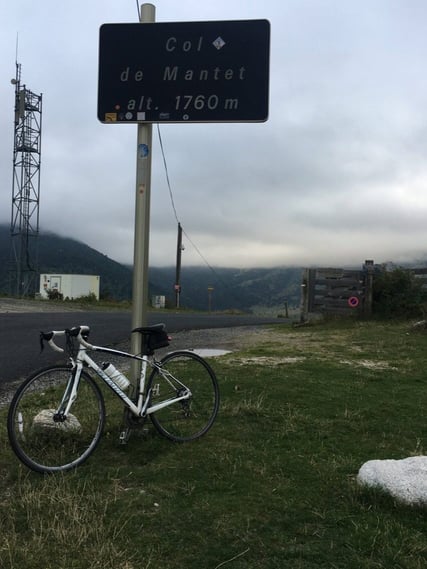How can Endurance Adventures/Races Promote Self-Actualisation?

There are many ways that humans can achieve self-actualisation, but there is a growing following which proposes that endurance adventures/races can be a really good way to achieve this. My own experience of taking part in these events, primarily through running is an overwhelming sense of psychological wellness and achievement when I finish an event despite my aching body. The harder the goal has been the greater this feeling of achievement and satisfaction becomes.
However, it’s not always that simple, because our feeling of satisfaction is very much dependent on what we view as success. Not meeting our ‘success’ criteria can actually lead to very negative feelings of frustration and disappointment. So how can you be sure that your endurance sport is contributing to self-actualisation?
What is Self-Actualisation?

Self-actualisation is a term that was used by the psychologist Abraham Maslow to describe how, once our basic needs are met, we strive to be better versions of our selves: ‘what a man can be he must be.’ As you can see, Self-Actualisation is the top pinnacle of the pyramid of hierarchy of needs and as such could be described as a ‘Western’ or ‘First World’ concern in that we can only focus on this once all our other basic needs are met.
So how does it all work? By our nature, once all our other basic needs are met, we as humans always seek to be better, we need to feel like we are progressing and moving forward. The nature of endurance sport is that regardless of our ability, we are physically moving our bodies forward to an end result every time we go out and train, culminating in our end goal or key target race. When this physical movement mirrors our psychological desire the result is a feeling of fulfilment, that we are doing what we are designed to do, that we are ‘finding ourselves’ through our sport. The peak of this would be when we achieve a particular goal, get to the end of the run/ride/adventure and the knowledge that we have somehow realised our potential is what brings the feeling of satisfaction.
Maslow first wrote about this theory in 1943 in Psychological Review, since that time the Western World has progressed massively; our lives are much more public through social media and in a society in which a large part of it’s financial structure is based on acquisition rather than production what we have has become a real focus. In a world where how we look and what we possess have become key indicators to success, ‘getting away from it all’ and ‘just being’ allows us to refocus on just being ourselves, on self-actualising away from the expectations of others. Nowhere is the pressure of external expectations felt more acutely than with young people, who are still experimenting and developing a sense of themselves. The Adventure Syndicate promotes and facilitates women to make and take part in (specifically bike) adventures. In their latest video ‘Should’ they show how teenaged girls can grow in their understanding of themselves and realise that there is more to life than snapchat followers. You might say that they are promoting self-actualisation in these young people.
Setting Realistic Goals/Expectations?
The beauty of an adventure is that you can set your own goals and expectations, you don’t have to be a slave to the expectations of others. By its nature an adventure is a challenge, but it only has to be a challenge to you for you to feel that sense of achievement. I can honestly say there have been times in my life where just getting out of the door has been a challenge, but once I overcame my fear and went out the sense of achievement was immense; the way I did this was by keeping the challenge realistic for me. In running this meant initially just doing a route I had walked previously so I knew I could get round, even if I had to stop and walk. Once I got over the challenge of getting out the door in my shorts and t-shirt, I began to set my goals higher, initially by running more frequently, but eventually by increasing the distance. Each time I achieved my new goal, I felt great, my confidence increased and other worries in my life began to matter less, I was doing my thing and I was loving it.
A good way to set realistic goals is to ask yourself three questions:-
What would I like to achieve? – This is about setting your own goal, is it getting to the end? Is it going further than you ever have before? Is it bettering your time on the race you did last year? It really doesn’t matter so long as your goal belongs to you and you are emotionally invested in it – having a sense of what your more actualised self would be on achieving the goal if you like.
What am I likely to achieve? – This is the reality check, based on your past experience, where you are now and the time you have to get to where you want to be. If you’ve done less training an improvement on last year’s time might need to be a longer term goal, if you’ve done more training then an improvement is eminently possible and certainly getting the same time as last year (depending on the event) is likely to happen. Some people really struggle to be positive about themselves and their abilities, whilst other people remain continually optimistic because they become so excited by what they want. If you know that you struggle to be realistic about yourself asking a good friend or your coach if you have one can be helpful. Once you have thought about this you might like to go back and revise ‘what you would like to achieve.’
What might I achieve? – This is the outside best you think you could achieve – it’s not certain but it’s not impossible. Here again, getting others’ opinions can be helpful, sometimes other people can see our potential where we can’t.


Your acceptance criteria is now defined as between what you are likely to achieve and what you might achieve. Once you have this range of criteria this provides you with a far more realistic goal than pass or fail, win or lose, which can set you up to fail. This is not pass or fail, it is about being open to your own capabilities and trying your best; your best comprises of the training you have done and the decisions you make as you enjoy your event, these will be the best decisions you can make with the information available to you at the time. Once you have decided that this is your race and you have your own acceptance criteria which is no win or lose but a margin of criteria that you would like to fall within, you can go about doing your thing rather than worrying about whether you are going to fail.
When it comes to racing it can be really easy to get sucked into the expectations of others or of our own. In fact I know people who simply won’t race for that reason. They often put themselves under a lot of pressure to perform and it becomes an all or nothing scenario. One thing I often say to clients who choose to race is ‘run your own race, not anybody else’s.’
Whatever it is you choose to do, your success will be dictated by your own expectation.
The Challenge
For a goal to be meaningful it needs to be a challenge, whether that’s physically, mentally or both. This is how the hierarchy of needs works in its order: we become engaged in the next challenge when the first ceases to be thus. This is why the further we go into what we might achieve, as opposed to what we are likely to achieve, the more satisfied we become. So what we might achieve has to be something that we are going to work towards, whilst accepting that we may in fact fall somewhere in between that and what we are likely to achieve. Whilst the possibility of not achieving everything we set out to do can be difficult, the nature of who we are is there needs to be a possibility of failure for us to feel the success. Getting out the door was once a genuine difficulty for me, so this was a challenge, and one that I had failed to do many times, so achieving it felt good. Moving forward into self-actualisation is not just about achieving what we know we can, but achieving what we think we might.
In endurance sports there are many ways we can challenge ourselves and this means that there are many options to suit a variety of levels. You can choose to go for distance (going for as far as you can), or you can choose to go for time (completing a given distance as fast as you can). For others, the challenges are more about the adventure: whether we could be self-sufficient on our bikes in nature for days at a time. Whatever your chosen challenge setting it optimistically but realistically is what will help you feel that sense of achievement and moving forward.
How can Endurance Sport Complement your Life?
In the case of endurance sport, it may be viewed to meet needs at various points along the hierarchy of needs and not exclusively at the top. For example, partaking in sport is a good way to increase self-esteem both in adults and children; it can be a good way to meet and form friendships with others and by joining a training group we can experience a sense of belonging.
As we progress to the more basic elements of the pyramid (warmth and cover and food and sleep) endurance sport can support these elements too in different ways. For example, during multi-day adventures, seeking and meeting our food and sleep needs can be part of the challenge and at times we have to think about how much we can compromise these and still complete the event. Equally, finding shelter and having appropriate warm clothing is another need we have to consider in longer events in order to complete them safely. It seems for some of us, having to think along these more basic needs is attractive in itself. In a world where we are continually bombarded with messages about how to lead the perfect life, perhaps having time away from the higher more pressured pursuits on the pyramid is just what we need in order to re-focus on what’s really important.
Most importantly, and the message that is clearly given in ‘Should’ endurance adventures can really help us be the person we want to be, whether that’s by giving us a break from the pressure of day to day living or by enabling us to achieve our utmost potential.
Supplementary Questions
What if I’m not confident enough? There are no rules to say you have to have your adventure on your own. If you feel like you need a helping hand with your confidence joining a supportive group or going out with a supportive friend can be very helpful.
What if I don’t have any money? Going on an adventure doesn’t have to cost much, in fact if you already have your bike or running shoes it doesn’t have to cost anything at all, it can be as simple as an adventure from your doorstep. A couple of years ago it was quite popular to climb the same height as Everest but using a local hill to do so.
January 30, 2020

Comments